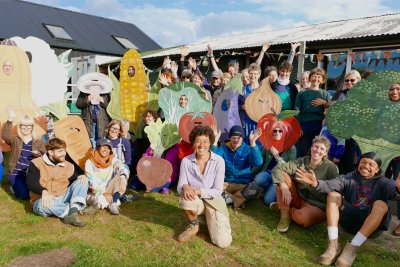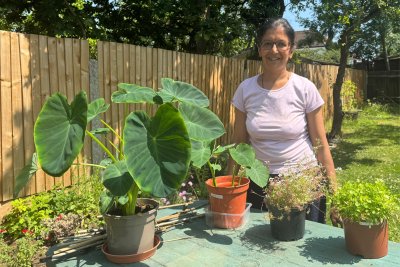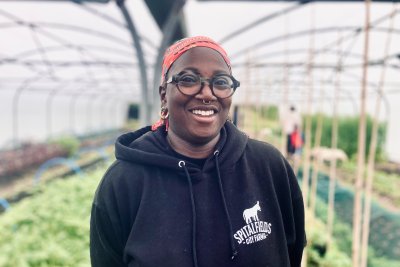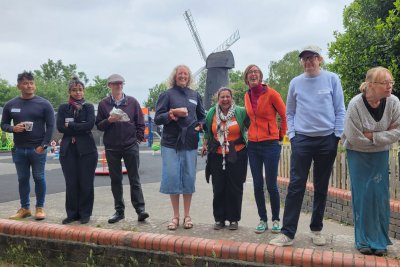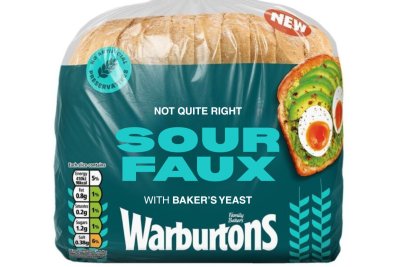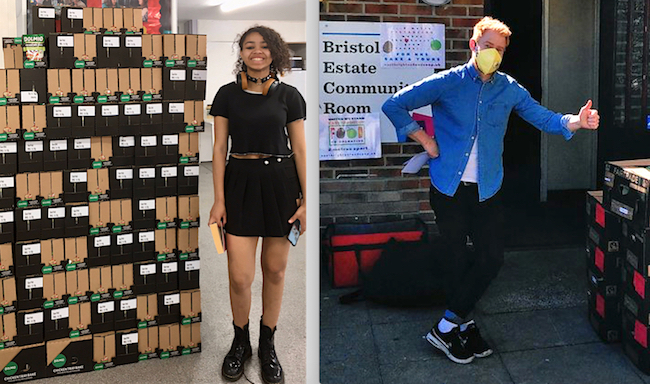 Credit Cooperation Kentish Town and Sussex Gleaning Network
Credit Cooperation Kentish Town and Sussex Gleaning Network

Community Building: 11 resources for developing thriving local food movements
What do our local areas need in place to resource and amplify public action on healthy and sustainable food? Vera Zakharov envisions a dynamic food landscape that can catalyse grassroots initiatives and support food citizens.
“I’m tired of protesting – I want to build.” Shiri, Cooperation Kentish Town organiser
If you’re in a hurry, jump straight to the list of eleven resources.
One of the first projects I got involved in after emigrating to the UK was the Lewes Road Community Garden - a community takeover of a derelict plot of land in a dense part of Brighton & Hove where many residents lacked private gardens and green space access. I met one of my best friends there, and adopted a seedling which is now a thriving tree in my garden. Despite a formidable citywide campaign to save it, the garden was ultimately dismantled to make way for another supermarket chain on a street already saturated with them. Other community gardens and composting spaces were inspired by the Lewes Road Garden, and the campaign had in a roundabout way gathered broad public support for the set up of HISBE, the city’s ethical supermarket. We saved whatever we could and repurposed it elsewhere.
In those early days, I learned the value of publicly-owned spaces in fostering both community and activism, and that people can build physical and social communities even with limited economic resources. Crucially, once these spaces are in place, any number of positive outcomes await.
Organisations such as the Food Citizenship project, National Food Service and New Local Government Network, among others, are arguing for a greater public stake in shaping food supply chains and policy, service provision and community asset management. And here at Sustain, we are arguing for the use and protection of public-owned spaces and assets as a key element in community wealth building and ensuring local food and economic security.
Meanwhile grassroots projects are, as ever, springing up and modeling the values of resource-sharing, community asset-building, and peer-to-peer support that feed community resilience. Through the Covid-19 crisis, these have been some of the quickest to respond to community needs, including social dining clubs, local pantries and food co-ops. But they should not be expected to build community resilience and food security on their own. It is the duty of local and national resource-holders to support them, materially and financially.
Our Sustainable Food Places programme is exploring what it takes to develop thriving local good food movements – networks of active food citizens and groups joining forces with community, council and local business sectors to reshape the food landscape for the better.
What we need in the mix is a map of what a thriving community-led local food system actually looks like. Such a vision can help food partnerships and other organisations plan where to add resources and project development. Crucially, this work should always start from a place of consulting and co-creating with local residents themselves, and ensuring that marginalised voices are heard. As an old saying goes, nothing about us without us.
Eleven resources for building an active and resilient food movement
1. Food governance friends and influential allies
Well-connected networks of organisations, particularly food governing structures such as food partnerships, food policy councils and food power alliances, have a proven track record on local food work in a time of crisis and in the long term. But they can also be effective conveners of diverse networks of groups, businesses, residents and councils, connecting up the grassroots and the institutional spheres, and are key allies. Local authorities should also put resource and strategic focus on supporting grassroots initiatives and networks with can reach people that councils can't. And local politicians, be they councillors or MPs, should automatically have a vested interested in the community food agenda on their patch (although some might need gentle reminding). Some challenges hindering community food activity can only be solved at a national level.
2. Volunteer and activist networks
A movement needs a network where to connect and organise, whether in person or online. An area with thriving community action on food needs multiple networks based on people’s interests and localities. Mutual Aid, multicultural, environmental and "friends of" groups are just some examples. Councils and organisations should reach out to these networks, especially where opportunities exist for them to share expertise and help shape strategies, while respecting the value of their independence. These networks also bring richness beyond food - they offer diverse and in some cases underrepresented perspectives, and should be involved in shaping local food systems.
3. Community buildings... with working kitchens!
Physical community spaces are the beating hearts of local neighourhoods, where people can be productive, look after each other and take action that improves the outcomes of their wider communities. Community centres, village halls and faith-based buildings should be equipped with adequate cooking and eating facilities, and protected for public use, with free or very affordable rental rates. In times of crisis, these spaces can be repurposed for emergency food provision. Any decision to take away such a key piece of neighbourhood infrastructure should be seriously considered, and likely resisted. Organisations such as Locality and the ACRE Network work to support local authorities and community groups in protecting these community assets.
4. Land for growing and more
Protecting public use of land for growing, composting and public events is as crucial as protecting community buildings. The case is well established on the mental and physical health benefits of community growing. But there is a broader argument to be made that productive public use of land reverses the documented negative impacts of derelict and underused land on community well-being, mental and physical health. CLES argue for and offer tools on socially just use of land and property. But it's not just about urban growing. Fertile agricultural land, such as that in city farms, county farms, parks or in green belts is a vital community asset for generations to come. It can allow community supported agriculture and shorter supply chains, attract new entrants into farming, promote biodiversity, and should be protected from development.
5. Shared equipment and resources
Here in Brighton I saw a lightning speed effort of community projects sharing equipment such as fridges and freezers to turn small community spaces into busy emergency food hubs. It’s costly and rather inefficient not to take a shared asset approach when it comes to resource-heavy food work. Beyond fridges, what other resources could be shared among communities? Event equipment, cooking equipment, trailers, even decorations! In addition to setting up community resource-sharing hubs, local organisations can take a shared asset approach when spending grant funding, putting in a long term community use plan for resources.
6. Dynamic community food hubs
Now what to use these spaces, land and resources for? Every area needs numerous user-led food-sharing projects that foster mutual support through food, make a case for protecting community resources by using them, and build networks for people to influence their food system collectively. Ideally every neighbourhood or ward will have a variety of projects, including growing spaces, cooking clubs, community fridges, communal composting and surplus-sharing initiatives. This is the basis for our vision of dynamic food hubs at the heart of every local community. Our Sustain campaigns have no shortage of toolkits for these, but the crucial bit is for food partnerships and local organisations to support these projects through network-building and sharing learning from outside of their local areas.
7. Planning levers
It’s not enough to rely on existing infrastructure to support community connections and productivity over food. If we are to accept these as vital neighbourhood infrastructure, as we do playgrounds and recycling bays, these must be written into local planning and development policies. Community kitchens, food growing spaces and provision for food enterprise should be written into and promoted through planning advice notes, but ultimately should become formal planning policy. We must look to collectively influence national policy to give local authorities more say over the provision of community infrastructure any time ground is broken to build housing and commercial spaces, and power to transform derelict spaces for community benefit when they are privately owned and left vacant.
8. Training opportunities
While the role of grassroots groups and local residents is to co-create and help run local initiatives and actions, this needs to be supported through training and peer to peer mentoring opportunities. This is the perfect role for food partnerships and other community alliances focusing on food. In addition to helping people develop in their role as community food leaders and gain transferable skills, community sector allies benefit from convening these loose and diverse networks to help feed into wider local food strategies. It’s a win-win. There are roles for local authorities in this arena too – who can provide public training on safeguarding and food safety, as well as performing DBS checks, lifting the cost burden from local groups while benefitting council priorities around public safety.
9. Alternative funding structures
One learning that I had gathered from grassroots groups and food partnerships involved in Covid emergency food responses was that, although funding was available locally, it was inaccessible to many local groups, who did not have the necessary constitution, bank accounts nor precious time to navigate formal grant funding processes. Alternative funding structures, such as the Brighton & Hove Food Partnership's Good Food Grants, can allow small groups to cover activity costs. They do away with complex reporting and benefit from local relationships built on trust. Not only that, such communal funding for grassroots food initiatives can motivate network-building and resource-sharing.
10. Support and space for food enterprise
Volunteer-run food project leaders of today can become the local food business leaders and job creators of tomorrow. Community food enterprises come in all shapes, from co-ops on housing estates to Community Supported Agriculture schemes. But support in the form of training, funding, access to processing facilities and outdoor/indoor market spaces are the necessary springboards for people to take their projects to the next level and build livelihoods around their passions. Field Brighton, a council-developer-university partnership, offered cheap meanwhile leases to community enterprises, allowing projects like Old Tree Brewery to grow into community businesses. And the Greenwich Cooperative Development Agency offers training and facilities rentals to budding food entrepreneurs in the borough. And it's not just about job-creation: supporting routes to market keeps passionate community-minded people in a sector otherwise dominated by corporations with little community stake.
11. Local food identity
With the ten aforementioned structures, networks and resources in place, a public-led good food movement needs its banner: a local identity based on shared values, strengths and vision that everyone can rally behind. Incredible Edible Todmorden Food Trails and Bristol's Going for Gold campaign are just a couple of examples. Be it an area-wide narrative championing neighbourliness, food-sharing, diversity or grassroots innovation, it gives both individuals and community groups a sense of shared purpose to keep up their motivation and creativity around food. Local allies, community resources, training and funding can help with this, as can public events, festivals and food happenings that bring people together and help tell the shared story on local good food and the people making it happen.
This blog forms some of the initial thinking on the local resourcing of public and grassroots engagement within the Sustainable Food Places network as part of our Good Food Movement work. We would love to hear your local perspective. What here resonates, what's working, what is proving challenging? Get in touch!
Sustainable Food Places: Network bringing together over 100 local food partnerships.
Sustain
The Green House
244-254 Cambridge Heath Road
London E2 9DA
020 3559 6777
sustain@sustainweb.org
Sustain advocates food and agriculture policies and practices that enhance the health and welfare of people and animals, improve the working and living environment, promote equity and enrich society and culture.
© Sustain 2025
Registered charity (no. 1018643)
Data privacy & cookies
Icons by Icons8


